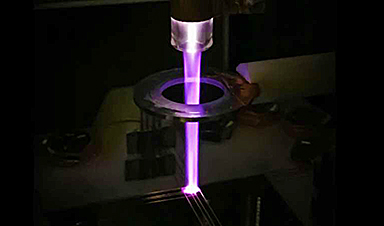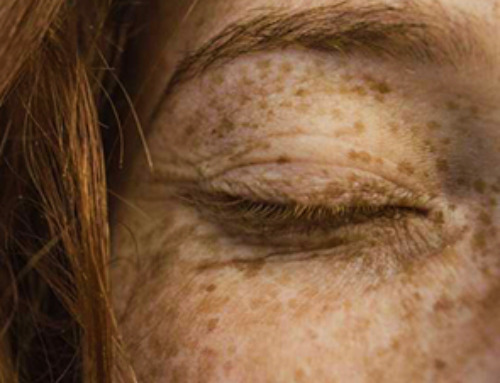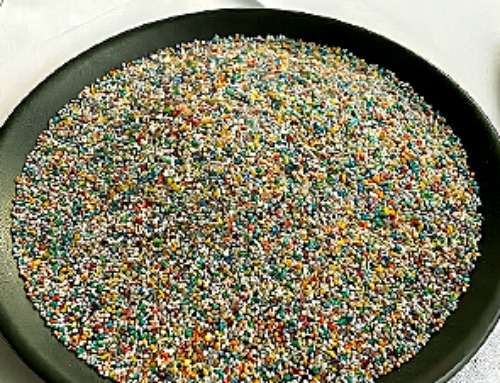Artificially intelligent software has been developed to enhance medical treatments that use jets of electrified gas known as plasma. The computer code predicts the chemicals emitted by plasma devices, which can be used to treat cancer, promote healthy tissue growth and sterilize surfaces.
The plasma studied in the experiments is known as cold atmospheric plasma (CAP). When the CAP jet is turned on, numerous chemical species in the plasma take part in thousands of reactions. These chemicals modify the cells undergoing treatment in different ways, depending on the chemical composition of the jet. While scientists know that CAPs can be used to kill cancer cells, treat wounds and kill bacteria on food, it’s not fully understood why.
“This research is a step toward gaining a deeper understanding of how and why CAP jets work and could also one day be used to refine their use,” said Yevgeny Raitses, a managing principal research physicist at the U.S. Department of Energy’s Princeton Plasma Physics Laboratory (PPPL).
The project was completed by the Princeton Collaborative Low Temperature Plasma Research Facility (PCRF), a collaboration between researchers at PPPL and the George Washington University (GWU).
PPPL has a growing body of work that combines its 70 years of pioneering plasma research with its expertise in AI to solve societal problems. The Lab’s mission extends beyond using plasma to generate fusion power to its use in fields such as medicine and manufacturing, among others.
The software uses an approach known as a physics-informed neural network (PINN). In a PINN, data is organized into parts called nodes and neurons. The flow of the data mimics the way information is processed in the human brain. Laws of physics are also added to the code.
“Knowing what comes out of the jet is very important. Knowing what comes out accurately is very difficult,” said Sophia Gershman, a lead PPPL research engineer from the PCRF who worked on this collaborative project. The process would require several different devices to collect different kinds of information about the jet.
“In practical studies, it is difficult to go and utilize all of the various technologically advanced diagnostics all at once for each device and for various types of surfaces that we treat,” Gershman explained.
Calculating the chemical composition one nanosecond at a time
Li Lin, a research scientist from GWU and the paper’s primary author, said it’s also difficult to calculate the chemicals in a CAP jet because the interactions need to be considered a nanosecond at a time.
“When you consider that the device is in operation for several minutes, the number of calculations makes the problem more than simply computationally intensive. It’s practically impossible,” Lin said. “Machine learning allows you to bypass the complicated part.”
The project began with a small set of real-world data that was gathered using a technique known as Fourier-transform infrared absorption spectroscopy. The researchers used that small dataset to create a broader set of data. That data was then used to train the neural network using an evolutionary algorithm, which is a type of computer code inspired by nature that searches for the best answers using a survival-of-the-fittest approach.
Several successive batches of data are generated using slightly different approaches, and only the best datasets from each round are carried through to the next round of training until the desired results are achieved.
Ultimately, the team was able to accurately calculate the chemical concentrations, gas temperature, electron temperature and electron concentration of the cold atmospheric plasma jet based on data gathered during real-world experiments.
In a cold atmospheric plasma, the electrons—small, negatively charged particles—can be very hot, though the other particles are close to room temperature. The electrons can be at a low enough concentration that the plasma doesn’t feel hot or burn the skin while still being able to have a significant effect on the targeted cells.
On the path to personalized plasma treatment
Michael Keidar, the A. James Clark Professor of Engineering at GWU and a frequent collaborator with PPPL who also worked on this project, said the long-term goal is to be able to perform these calculations fast enough that the software can automatically adjust the plasma during a procedure to optimize treatment. Keidar is currently working on a prototype of such a “plasma adaptive” device in his lab.
“Ideally, it can be personalized. The way we envision it, you treat the patient, and the response of every patient will be different,” Keidar explained. “So, you can measure the response in real-time and then try to inform, using feedback and machine learning, the right settings in the plasma-producing device.”
More research needs to be done to perfect such a device. For example, this study looked at the CAP jet over time but at only one point in space. Further research would need to broaden the work so it considers multiple points along the jet’s output stream.
The study also looked at the plasma plume in isolation. Future experiments would need to integrate the surfaces treated by the plasma to see how that impacts the chemical composition at the treatment site.
More information: Li Lin et al, Data-driven prediction of the output composition of an atmospheric pressure plasma jet, Journal of Physics D: Applied Physics (2023). DOI: 10.1088/1361-6463/acfcc7
News
Platelet-inspired nanoparticles could improve treatment of inflammatory diseases
Scientists have developed platelet-inspired nanoparticles that deliver anti-inflammatory drugs directly to brain-computer interface implants, doubling their effectiveness. Scientists have found a way to improve the performance of brain-computer interface (BCI) electrodes by delivering anti-inflammatory drugs directly [...]
After 150 years, a new chapter in cancer therapy is finally beginning
For decades, researchers have been looking for ways to destroy cancer cells in a targeted manner without further weakening the body. But for many patients whose immune system is severely impaired by chemotherapy or radiation, [...]
Older chemical libraries show promise for fighting resistant strains of COVID-19 virus
SARS‑CoV‑2, the virus that causes COVID-19, continues to mutate, with some newer strains becoming less responsive to current antiviral treatments like Paxlovid. Now, University of California San Diego scientists and an international team of [...]
Lower doses of immunotherapy for skin cancer give better results, study suggests
According to a new study, lower doses of approved immunotherapy for malignant melanoma can give better results against tumors, while reducing side effects. This is reported by researchers at Karolinska Institutet in the Journal of the National [...]
Researchers highlight five pathways through which microplastics can harm the brain
Microplastics could be fueling neurodegenerative diseases like Alzheimer's and Parkinson's, with a new study highlighting five ways microplastics can trigger inflammation and damage in the brain. More than 57 million people live with dementia, [...]
Tiny Metal Nanodots Obliterate Cancer Cells While Largely Sparing Healthy Tissue
Scientists have developed tiny metal-oxide particles that push cancer cells past their stress limits while sparing healthy tissue. An international team led by RMIT University has developed tiny particles called nanodots, crafted from a metallic compound, [...]
Gold Nanoclusters Could Supercharge Quantum Computers
Researchers found that gold “super atoms” can behave like the atoms in top-tier quantum systems—only far easier to scale. These tiny clusters can be customized at the molecular level, offering a powerful, tunable foundation [...]
A single shot of HPV vaccine may be enough to fight cervical cancer, study finds
WASHINGTON -- A single HPV vaccination appears just as effective as two doses at preventing the viral infection that causes cervical cancer, researchers reported Wednesday. HPV, or human papillomavirus, is very common and spread [...]
New technique overcomes technological barrier in 3D brain imaging
Scientists at the Swiss Light Source SLS have succeeded in mapping a piece of brain tissue in 3D at unprecedented resolution using X-rays, non-destructively. The breakthrough overcomes a long-standing technological barrier that had limited [...]
Scientists Uncover Hidden Blood Pattern in Long COVID
Researchers found persistent microclot and NET structures in Long COVID blood that may explain long-lasting symptoms. Researchers examining Long COVID have identified a structural connection between circulating microclots and neutrophil extracellular traps (NETs). The [...]
This Cellular Trick Helps Cancer Spread, but Could Also Stop It
Groups of normal cbiells can sense far into their surroundings, helping explain cancer cell migration. Understanding this ability could lead to new ways to limit tumor spread. The tale of the princess and the [...]
New mRNA therapy targets drug-resistant pneumonia
Bacteria that multiply on surfaces are a major headache in health care when they gain a foothold on, for example, implants or in catheters. Researchers at Chalmers University of Technology in Sweden have found [...]
Current Heart Health Guidelines Are Failing To Catch a Deadly Genetic Killer
New research reveals that standard screening misses most people with a common inherited cholesterol disorder. A Mayo Clinic study reports that current genetic screening guidelines overlook most people who have familial hypercholesterolemia, an inherited disorder that [...]
Scientists Identify the Evolutionary “Purpose” of Consciousness
Summary: Researchers at Ruhr University Bochum explore why consciousness evolved and why different species developed it in distinct ways. By comparing humans with birds, they show that complex awareness may arise through different neural architectures yet [...]
Novel mRNA therapy curbs antibiotic-resistant infections in preclinical lung models
Researchers at the Icahn School of Medicine at Mount Sinai and collaborators have reported early success with a novel mRNA-based therapy designed to combat antibiotic-resistant bacteria. The findings, published in Nature Biotechnology, show that in [...]
New skin-permeable polymer delivers insulin without needles
A breakthrough zwitterionic polymer slips through the skin’s toughest barriers, carrying insulin deep into tissue and normalizing blood sugar, offering patients a painless alternative to daily injections. A recent study published in the journal Nature examines [...]





















